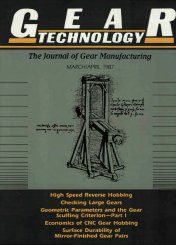Gear manufacturing schedules that provide both quality and economy are dependent on efficient quality control
techniques with reliable measuring equipment. Given the multitude of possible gear deviations, which can be found only by systematic and detailed measuring of the gear teeth, adequate quality control systems are needed. This is especially true for large gears, on which remachining or rejected
workpieces create very high costs. First, observation of the gears allows adjustment of the settings on the equipment right at the beginning of the process and helps to avoid unproductive
working cycles. Second, the knowledge of deviations produced on the workpiece helps disclose chance inadequacies on the production side: e.g., faults in the machines and tools used, and provides an opportunity to remedy them.
